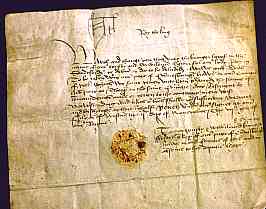



If you are looking at this page without frames, there is more information about medieval writing to be found by going to the home page (framed) or the site map (no frames).
| Warrants (2) | |||
| The offices of the privy seal and the signet did not record copies of their output on to rolls. Consequently the main evidence for their activities is in the warrants themselves, preserved in the secretariats to which they were sent, and ultimately ending up in the National Archives in London. There are vast numbers extant, but naturally, over the centuries, large numbers of the multitudes of little separate bits of parchment have vanished in the way that small things often do. | |||
 |
Chancery warrant of 1515 of King Henry VIII (Nottinghamshire Archives DDFJ 10/9/3). By permission of Nottinghamshire Archives. | ||
| The term warrant is also used for documents sent under the signet or privy seal to royal officials giving orders or instructions. The above example orders Sir Thomas Fitzwilliam, keeper of the park at Connesburgh Hawe, to deliver 12 quick does for Bryan Sandeford, Squire of the Body, to stock his park at Thorp. The text is in English. The above example formerly had the seal attached to the face of the document. This gives it the essential character of a writ, although not issued under the great seal. | |||
 |
 |
 |
|
| Because I know you love terminological confusion as much as I do, I must report that the word warrant also has a more generalised usage which predates all this bureaucratic complexity. In the 12th and 13th centuries the process was instigated whereby travellers who went from town to town had to carry written certificates of good character or certificates indicating that the horses or livestock in their possession actually belonged to them. People were very suspicious of travellers in those days. These authenticating certificates are sometimes referred to as warrants. In fact any authenticating document, including, dare we say it, a charter, may be referred to as a warrant in a generic sense. | |||
| I suppose the main point about the terminology of documents is that as written bureaucracy became more complex, terms changed their meaning. Usually this was in the direction of the general to the particular. Words in general use became appropriated to specific meanings within the newly developing systems. | |||
|
|
|||
|
|
|||
|
If you are looking at this page without frames, there is more information about medieval writing to be found by going to the home page (framed) or the site map (no frames). |
|||